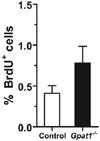Mice deficient in glycerol-3-phosphate acyltransferase-1 have a reduced susceptibility to liver cancer
- PMID: 22215515
- PMCID: PMC3640291
- DOI: 10.1177/0192623311432298
Mice deficient in glycerol-3-phosphate acyltransferase-1 have a reduced susceptibility to liver cancer
Abstract
The risk of hepatocellular carcinoma increases with the persistence of non-alcoholic fatty liver disease. Triacylglycerol synthesis is initiated by glycerol-3-phosphate acyltransferase (GPAT). Of four isoforms, GPAT1 contributes 30-50% of total liver GPAT activity, and we hypothesized that it might influence liver susceptibility to tumorigenesis. C57Bl/6 mice deficient in GPAT1 were backcrossed 6 times to C3H mice. After exposure to the carcinogen diethylnitrosamine (DEN) and the tumor promoter phenobarbital, male Gpat1⁻/⁻ mice, compared with controls (Gpat1⁺/⁺), had 93% fewer macroscopically visible nodules per liver at 21 weeks of age and 39% fewer at 34 weeks of age. Microscopically, control mice had increased numbers of foci of altered hepatocytes, particularly the basophilic subtype, as well as more, and malignant, liver neoplasms than did the Gpat1⁻/⁻ mice. At 21 weeks of age, 50% (4/8) of control mice (50%) had hepatocellular adenomas with an average multiplicity (tumors per tumor-bearing-animal) of 4.3, while none occurred in 8 Gpat1⁻/⁻ mice. At 34 weeks of age, all 15 control mice (100%) had hepatocellular adenomas with an average multiplicity of 5.2 compared to an incidence of 93% in Gpat1⁻/⁻ mice and multiplicity of 3.1. HCCs were observed in 13% of control mice and in only 6% of Gpat1⁻/⁻ mice. These data show that alterations in the formation of complex lipids catalyzed by Gpat1 reduce susceptibility to DEN-induced liver tumorigenesis.
Figures





References
-
- Bogacka I, Ukropcova B, McNeil M, Gimble JM, Smith SR. Structural and functional consequences of mitochondrial biogenesis in human adipocytes in vitro. J Clin Endocrinol Metab. 2005;90:6650–6656. - PubMed
-
- Bosch FX, Ribes J, Diaz M, Cleries R. Primary liver cancer: worldwide incidence and trends. Gastroenterology. 2004;127:S5–S16. - PubMed
-
- Chang Y-Y, Kennedy EP. Biosynthesis of phosphatidyl glycerophosphate in Escherichia coli. J Lipid Res. 1967;8:447–455. - PubMed
Publication types
MeSH terms
Substances
Grants and funding
LinkOut - more resources
Full Text Sources
Other Literature Sources
Molecular Biology Databases

